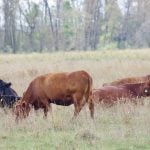
Tag Archives soil health
Systems clash
Regen ag, consumer messaging and an agricultural schism

Feds open up consultations for sustainable ag strategy
Producer groups to have reps on advisory committee

Cows for crops? Searching for the low-hanging fruit on carbon
Building soil carbon must make sense at the bank and in the work day

Comment: Soil matters – charting a path forward
Action is needed to preserve and improve soil health, but it must be judicious

Soil sampling shows depleted fields
High yields, soil leaching and less N applications due to high prices drew down soil nitrogen this season

Comment: The problem of microplastics
Natural fertilizers contain them, yet we know next to nothing about their environmental and health impacts

Controlled traffic farming is proving its worth, say advocates
The system ‘shines’ during droughts and lets farmers seed and harvest sooner when it’s wet, they say

National soil health study set to launch
It’s been decades since the last study was completed in 1984

COVER CROPS: Give ’em a shot and have some fun, says soil health expert
The short season here is a challenge, but there are ways to profit from this much-discussed practice



